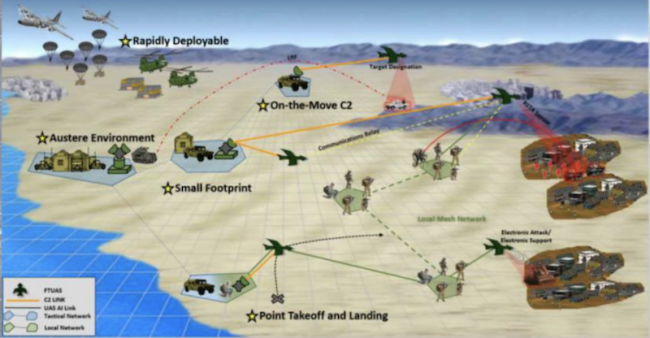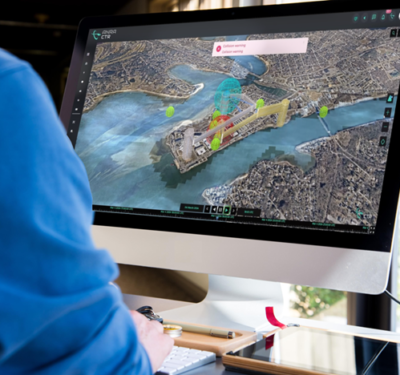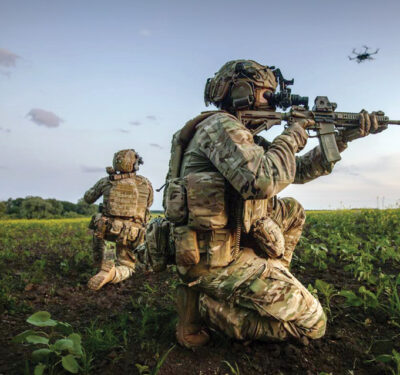
Graphic courtesy of Col. Joseph Anderson, U.S. Army/Vertical Flight Society Symposium.
The origins of the Army’s famous battle cry, “Hooah!” are up for debate. Some say it comes from a World War II Airborne acronym “HUA,” standing for “heard, understood, acknowledged.” Perhaps now it can also mean “High Up in the Air.” At least that’s what one might believe after hearing a keynote from the Army’s COL Joseph Anderson, Program Manager for Unmanned Aircraft Systems (UAS) at the recent Vertical Flight Society’s 9th Biennial Autonomous VTOL Technical Meeting and 8th Annual Electric VTOL Symposium.
According to Anderson, the Army’s UAS have been the same for more than a decade. He described how, at first, troops used the Shadow, Puma, and Gray Eagle unmanned aircraft systems (UAS) for intelligence, surveillance and reconnaissance (ISR) and then later, for targeting the enemy through kinetic strikes. These use cases continue to be valid; however, the Army seeks to modify its entire portfolio to “fight and win in a multi-domain operations (MDO) environment,” consistent with the Army Modernization Strategy.
In this strategy document, the Army has listed future vertical lift platforms and related technologies as one of it’s six modernization priorities, to “increase the maneuverability, endurance, lethality, and survivability of Army aircraft.” The effects sought include, among other things, UAS. Thus, for the Army, future UAS and vertical lift, in many respects, are intertwined.
And so, the troops have saluted smartly and moved out. The Army spearheaded a multi-service initiative, Future Vertical Lift, focused on “enhancing vertical lift dominance through the development of next generation capabilities.” This cross-service and cross-functional team, in turn, is leading the Future Tactical UAS (FTUAS) program, which went live last year. In April 2020, Inside Unmanned reported that FTUAS is “an integral part of the Army’s Future Vertical Lift initiative ‘to integrate situational awareness, supervised autonomy, advanced manned/unmanned teaming and scalable and tailorable lethal/non-lethal fires and effects.’”
As part of the FTUAS initiative, infantry soldiers, including paratroopers, field-tested four of the industry’s most advanced tactical UAS: Textron Systems Corporation’s Aerosonde HQ UAS, Martin UAV’s V-BAT long endurance VTOL, L3Harris’ FVR-90 and Arcturus UAV’s Jump 20 VTOL. Anderson describes this initial effort as a “Buy, Try, Inform” effort, wherein the Army buys small quantities of aircraft and has soldiers try them out to inform later acquisitions.
The FTUAS project is running in parallel with a number of other separate and distinct UAS modernization efforts, including the Joint Tactical Autonomous Aerial Resupply System (JTAARS), Autonomous Aerial Resupply Concept initiative. JTAARS is a joint effort by the Army Futures Command’s Sustainment Capabilities Development and Integration Directorate and the Marine Corps’ Capabilities Development and Integration office to use larger drones for medium payload (up to 800 pounds) automated UAS capabilities for future MDO Infantry Brigade Combat Team (IBCT) organic sustainment (read: resupply). Just two weeks ago, an RFI launched seeking industry input on the initial concept of operations.
The Army is clearly paying much more than just lip service to both of these modernization efforts. They realigned more than $33B in the FY2020-2024 Program Objective Memorandum (POM—budgeting document) to fund them.
With regards to both programs, taking a page from the Air Force’s playbook, Anderson states, “adaptability and flexibility are key” (USAF: “Flexibility is the key to airpower”). For the FTUAS program in particular, without providing too much inside information, the Colonel revealed that, based on the initial trials, the Army can be expected to produce a capabilities development document (CDD) early this year. What will that CCD look like? Unclear. However, according to Anderson, “The #1 requirement is no runway needed.” The Army Requirements Oversight Council will be meeting to review the FTUAS CDD before it launches.
Stay tuned for more Army UAS “HUA”—both big and small—in 2021.
BIO:
Dawn M.K. Zoldi (Colonel, USAF, Retired) is a licensed attorney and a 25-year Air Force veteran. She is an internationally recognized expert on unmanned aircraft system law and policy, a recipient of the Woman to Watch in UAS (Leadership) Award 2019, and the CEO of P3 Tech Consulting LLC.






